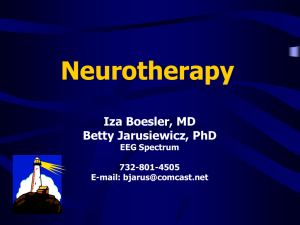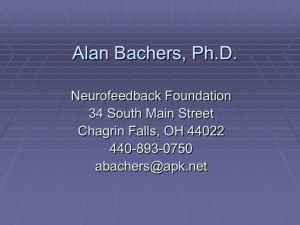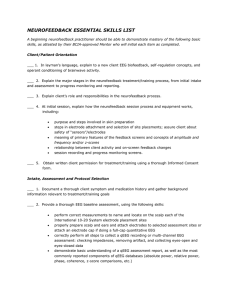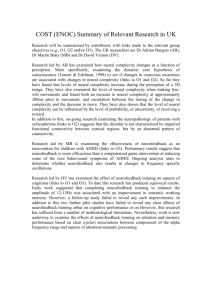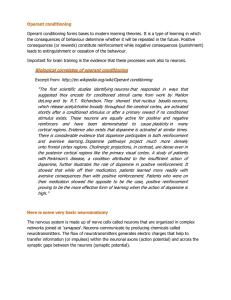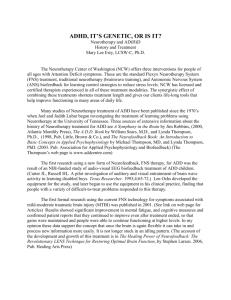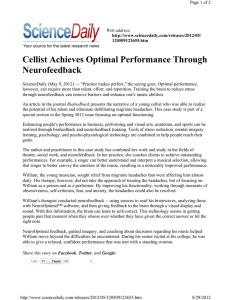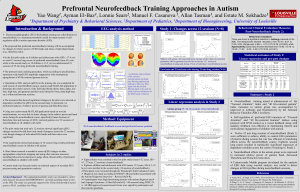Neurofeedback
advertisement
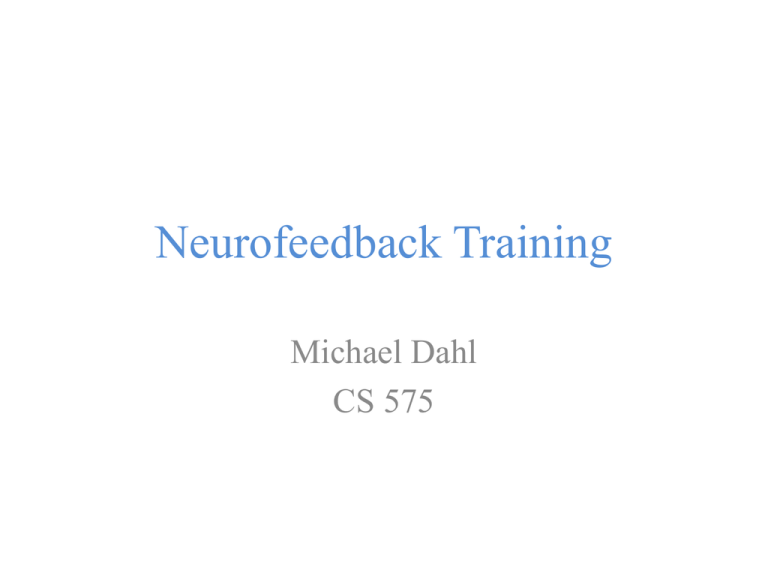
Neurofeedback Training Michael Dahl CS 575 Introduction • Goal: Learning to self-regulate one’s own brain • It is technology’s answer to psychotherapy, cognitive rehabilitation, and poor cerebral functioning – Mental Health Professionals – Educators – Occupational Therapists – Rehabilitation Counselors – Doctors Biofeedback • Attaching sensors to the body for purpose of acquiring biological signals such as: – Heart rate – Muscle tension – Body temperature –… • Neurofeedback is a type of biofeedback – Brains electrical activity Inside the Brain • Neurons Detecting activity inside the Brain • When many neurons fire at the same time, they may produce electrical activity detectable to an electrode placed on the head. • Electroencephalograph (EEG) - Graphical representation of neuronal activities in the brain. Early History • 1875: Richard Canton – First person to record electrical activity from the brain. He discovered fluctuation in the brain’s electrical activity follow mental activity • 1920’s: Hans Berger – First to measure EEG on human scalp. Discovered several types of brainwaves Berger’s EEG recording apparatus Berger’s electrode cap Brain wave types Performance and Arousal More History • 1963: Joseph Kamiya – trained patient to recognize alpha state through verbal reinforcement • 1968: Barry Sterman – Trained cats to increase SMR Modern Developments • 1970’s – 1980’s: QEEG • 1980’s – 1990’s: Use of computer graphics and sound for neurofeedback training Brain regions • Each region of the brain is associated with specific fundamental operations Example locations: International 10-20 System of Electrode Placement Equipment for neurofeedback • Desktop PC (preferably double monitor) • Brain amp • Electrodes and paste Equipment for neurofeedback • Software – Program for data acquisition, processing and display (i.e. BioExplorer) - Video games, movie player, …. Snapshot of data at site cz Normative OCD / Anxiety Disorders ADHD PTSD QEEG • • • • Developed in 1970’s / 1980’s 19 sensors on scalp Broad picture of the brain in action Can compare results to normative database – Often used to access progress of neuorofeedback training QEEG comparison EEG Signatures EEG Signatures for ADD EEG Signatures for Anxiety Disorders Two branches of treatment • Normalizing the EEG • Personal growth and mental flexibility (peek performance) Video • Chris Kaman’s Story – NBA basketball player for the Clippers – http://www.youtube.com/neurocoretv#p/a/u/1/PWn dvoCjrxY Near Future • Virtual Reality – Enhance neurofeedback in a couple ways • The total immersion and totality of the feedback allows the patient to focus completely on his physiology without distraction • More engaging and motivating for the client Some Predictions for the Future • At some point, every home will have one. We will all hook up to a machine with electrodes. It will be as common as physical exercise. • Someday people may even wear tiny computers to monitor their EEG and tell them when they need to make adjustments. Conclusion • Field of neurofeedback is still in its infancy – Research in thin – Clinical outcome studies are overwhelming • Research needs to be funded to gain support of insurance companies, schools, and doctors


